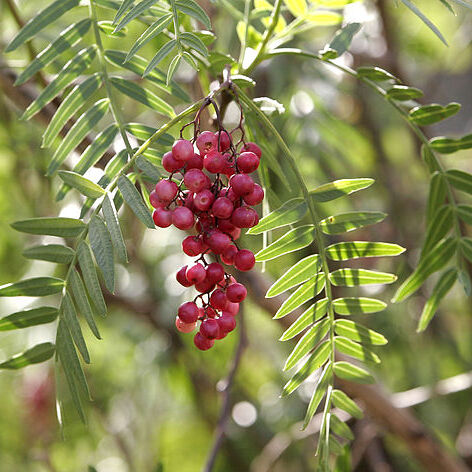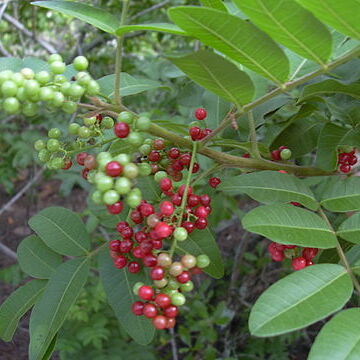Herbs, perennial or rarely annual. Rhizomes short. Culms terete. Leaves basal or cauline; sheath reddish brown; leaf blade flat, 3-angled, or semiterete. Involucral bracts leaflike, sheathing. Inflorescences paniculate, racemose, or rarely headlike. Spikelets usually narrowly ovoid or oblong-ovoid, usually 1-4-flowered, basal 1 or 2 flowers usually bisexual, apical 1 or 2 flowers male. Glumes dark colored with whitish margin, distichous, usually papery, deciduous, 1-veined, keeled, basal 2 or 3 empty. Perianth bristles 6 or absent. Stamens 3. Style slender; stigmas 3. Nutlet ellipsoid or obovoid, usually terete, 3-sided, or rarely biconvex, smooth or with reticulate ornamentation.
Shrubs or trees, dioecious or sometimes polygamodioecious. Leaves alternate, simple (not in Australia) or imparipinnate; rachis slightly winged; leaflets sessile or subsessile. Sepals 4 or 5. Petals 4 or 5. Male flowers: stamens 8–10, inserted below margin of disc, the alternipetalous ones longer; anthers dorsifixed, introrse; disc lobed between filaments; pistillode present. Female flowers: staminodes 8–10; ovary seated on disc, 1-locular, with 1 ovule suspended shortly below apex; styles 3, rarely 4, united at base; stigmas 3, rarely 4. Fruit a drupe; exocarp membranous, shining, fragile, separating from mesocarp at maturity; mesocarp resinous, adhering to bony endocarp.
Herbs, perennial, cespitose, rhizomatous. Culms distally branched, terete. Leaves basal; ligules absent; blades involute or subcylindric. Inflorescences terminal, sometimes pseudolateral, capitate [diffusely branched]; spikelets (1–)10–25, black or very dark purple; involucral bracts 1–2, spreading or erect, leaflike. Spikelets: scales 3–8, distichous, black or very dark purple, 2–3 proximal scales empty, distal scales each subtending flower. Flowers bisexual; perianth bristles 0–6, shorter or longer than achene, smooth or scabrous; stamens 3; styles deciduous, linear, 3-fid. Achenes rounded-trigonous to subterete.
Trees or large shrubs, usually dioecious, mostly evergreen, resinous. Lvs alternate, simple or imparipinnate. Fls small, in open panicles or racemosely arranged. Calyx (4)-5-partite; segments imbricate. Petals (4)-5, imbricate, whitish. Stamens 10, inserted on a disc. Ovary 1-locular, sessile; ovule suspended from apex; styles 3. Drupe globose; exocarp chartaceous.


